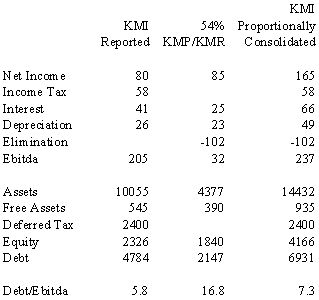October
21, 2002; Liabilities May Exceed Assets for Kinder Morgan
Much
of the energy infrastructure industry today seems well along on the path of debt
deflation. Financial failures
have put assets on the market. The
lack of well-capitalized buyers has driven down asset prices further.
Companies heretofore considered healthy are now under surprising
pressure. Kinder Morgan calls
attention to the industry condition as it has apparently applied to the Federal
Energy Regulatory Commission for the right to take action against customers who
suffer deterioration in credit. Perhaps the customers should require some protection from a
weakening in Kinder Morganís condition.
Kinder
Morgan's accounting conceals the company's true debt position.
Kinder Morgan leaves the debt of one entity off the balance sheet of the
other even though the entities are closely interlocked.
That action is supposedly justified because KMI nominally owns less than
20% of KMP/KMR. For convenience,
companies that own less than 20% of an affiliate report just the profit from the
affiliate and none of the debt. We
point out that when the general partnersí take is considered, Kinder Morgan
"owns" 54% of KMP/KMR.
Here is how the numbers might work using the results just reported for the last quarter. We take the reported results from KMI in the first column and calculate a debt to cash flow multiple, Debt/Earnings Before Interest, Tax and Depreciation (Ebitda). We calculate cash flow as the sum of items above Ebitda and we calculate Debt as Assets minus the three items below it. Annualizing the latest quarterís cash flow by multiplying by four leads to a multiple of 5.8 times (see Table).
 |
The going market for energy infrastructure properties may be about six to seven times cash flow. Apparently that is what Kinder Morgan might pay for new acquisitions. On that basis if KMIís existing assets are worth the same as new acquisitions, then KMIís debt at 5.8 times cash flow is exceeded by the value of KMIís assets and KMI is solvent.
Meanwhile
consider that half of KMIís cash flow is from KMP/KMR.
KMIís Ebitda of $205 million includes $102 million of profit from KMP/KMR.
Yet, KMI reports none of the KMP/KMR debt on its statements that we can
find.
Thus
we make an adjustment similar to what some call proportional consolidation. The
technique gives KMI credit for the cash flow and debt of KMP/KMR in proportion
to its ownership.
KMI
apparently owns 32 million units or shares of the average 175 million KMP/KMR
units/shares outstanding in the third quarter.
That looks like less than 20%. Yet
the general partner gets some 44% of the net income and 40% of the distributions
of the partnerships currently. If
the general partnerís interest is about 44%, it is equivalent to perhaps 139
million units/shares. Thus KMI has
the equivalent of 171 of 314 million units, or 54% of KMP/KMR.
Consolidating
54% of the cash flow and debt of KMP/KMR with KMI expands the debt to cash flow
ratio to 7.3 times. Yet the
consolidated entity may be worth only 6 to 7 times in the debt deflation
environment. As a result, KMI
appears insolvent. The emperor has
no clothes, as the fable tells